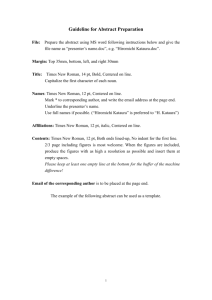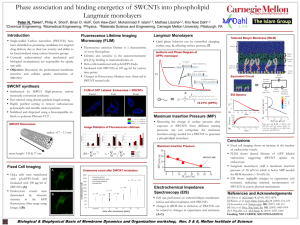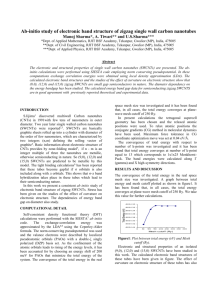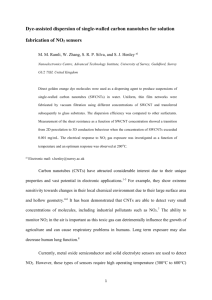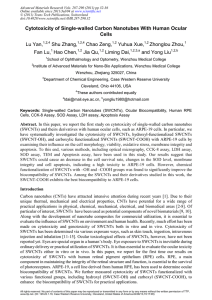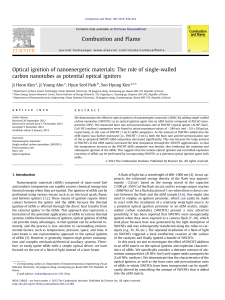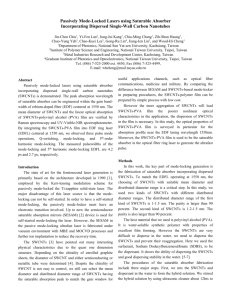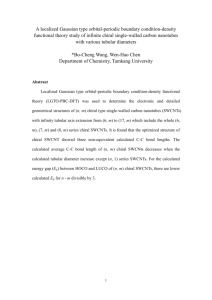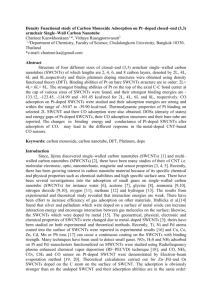Supplementary_Material
advertisement
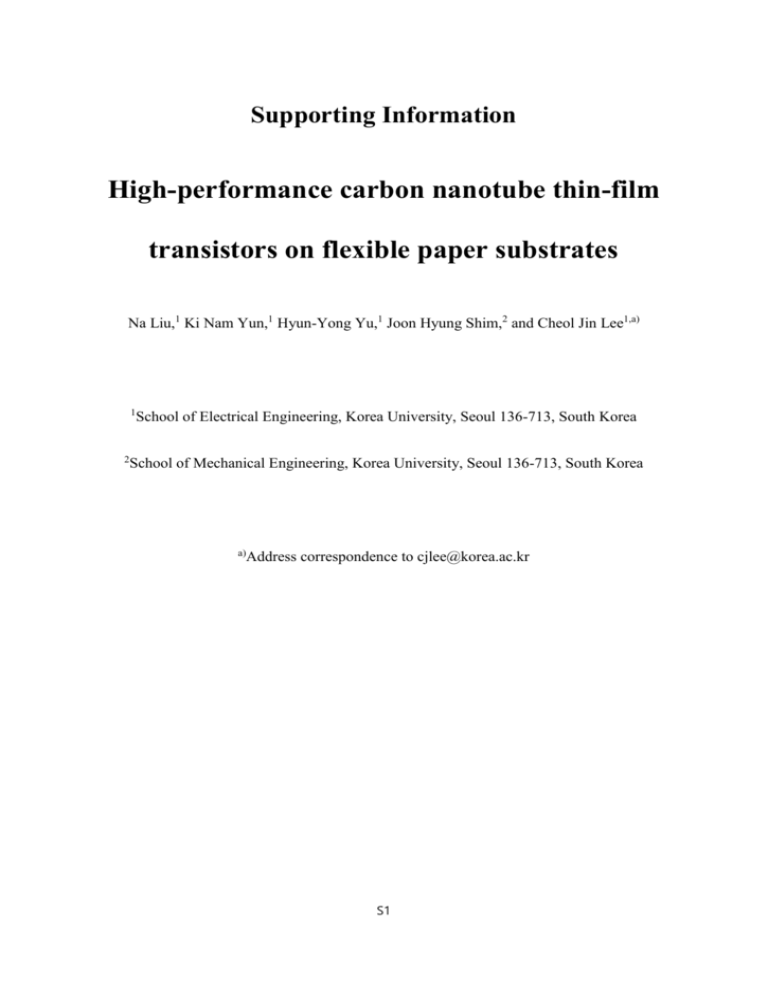
Supporting Information High-performance carbon nanotube thin-film transistors on flexible paper substrates Na Liu,1 Ki Nam Yun,1 Hyun-Yong Yu,1 Joon Hyung Shim,2 and Cheol Jin Lee1,a) 1 2 School of Electrical Engineering, Korea University, Seoul 136-713, South Korea School of Mechanical Engineering, Korea University, Seoul 136-713, South Korea a) Address correspondence to cjlee@korea.ac.kr S1 1. Characterization of the semiconducting single-walled carbon nanotubes (SWCNTs) The SWCNTs used in this work is 98% separated semiconducting SWCNTs (Nanointegris Inc.). Raman and UV-visible absorption spectroscopies were applied to estimate the quality, diameter and electronic properties of the semiconducting SWCNTs. Figure S1(a) shows a Raman spectrum of the SWCNTs observed with 514.5 nm laser line. The tangential mode (Gband, ~1580 cm−1) is related with SWCNTs crystallinity whereas disordered carbon mode (Dband, ~1350 cm−1) reflects defects.1 The high ratio of the intensity of G-peak and D-peak (IG/ID = 161.5) indicates high purity and high structure integrity of the SWCNTs. The inset of the Fig. S1(a) is the radial breathing mode (RBM), from which we can estimate the diameter and electronic properties of the SWCNTs. There are three strong peaks appearing at 159.5, 179.1 and 191.4 cm−1. As ωRBM = 248/d, the most SWCNTs with a diameter in the range of 1.30–1.55 nm.2 On the other hand, the metallic and semiconducting features of the SWCNTs are determined from the Kataura plot.3 All the three strong peaks are originated from the semiconducting SWCNTs, indicating abundant existence of the semiconducting SWCNTs. Figure S1(b) shows UV-visible absorption spectra of the separated semiconducting SWCNTs (red line) together with that of mixed SWCNTs (blue dashed line) for comparison. It can be seen from the spectrum of semiconducting SWCNTs that the S22, S33 and S44 transition peaks are strong; by contrast, the M11 transition peak is almost inexistence.4 This demonstrates the enrichment of semiconducting SWCNTs in the separated SWCNTs solution. S2 M22 S33, S44 M11 179.1 IG/ID = 161.5 191.4 159.5 100 150 200 250 Absorbance (a.u.) (b) Intensity (a.u.) (a) 100 200 1200 1500 1800 -1 Raman shift (cm ) 0.6 s-SWCNTs Mixed SWCNTs 0.5 0.4 0.3 0.2 400 S33, S44 M11 S22 600 800 1000 Wavelength (nm) FIG. S1. (a) Raman spectrum of the semiconducting SWCNTs. Inset: RBM mode of the Raman spectrum. (b) UV-visible absorption spectra of the semiconducting SWCNTS (sSWCNTs) (red line) and mixed SWCNTs (blue dashed line). To understand the length of the SWCNTs, the SWCNTs deposited on SiO2/Si substrates were measured using atomic force microscopy (AFM) (Fig. S2(a) and (b)). Eighty SWCNTs (or bundles) were evaluated and the distribution of the SWCNT length is shown in Fig. S2(c). The average length of the SWCNT is about 1.75 m. FIG. S2. (a, b) AFM images of the SWCNTs deposited on SiO2/Si substrate. (c) Histogram showing the distribution of the SWCNT length. S3 2. Hysteresis of the SWCNT transistor Figure S3(a) shows the transfer characteristics of the transistor with two directions sweeps. The Vgs is swept continuously from 20 to −30 V, then back to 20 V. A little hysteresis can be observed in the transfer characteristics. The hysteresis is typically attributed to charge trapping by absorbing water molecules on SWCNT surface and dielectric layer or charge injection into dielectric layer.5 However, the origin of the hysteresis is still unknown.6 The hysteresis highly dependents on the sweep direction, sweep rate and environmental conditions.7,8 The plateau appearing at low Vgs of the backward sweep is thought to be due to the hysteresis effect and especially reliance on the sweep direction. Figure S3(b) shows the transconductance (gm) of the transistor which is obtained by taking derivative of the transfer characteristics. From the gm–Vgs characteristics, one can find that the maximum gm of the forward and backward sweeps is different. The device mobility is calculated with the maximum gm using the equation (1) shown in the manuscript. The calculated device mobilities are approximately 2.0 and 2.9 cm2/V·s when the maximum gm extracted from the forward and backward sweeps, respectively. For consistency of the mobility calculations, all the maximum gm are extracted from the backward sweeps in this paper. S4 (a) (b) 0.20 Vds = -1 V gm (S) -Ids (A) 2.0 1.5 1.0 0.5 0.0 -30 Vds = -1 V 0.15 0.10 0.05 -20 -10 0 10 0.00 -30 20 Vgs (V) -20 -10 0 10 20 Vgs (V) FIG. S3. (a) Transfer (Ids–Vgs) characteristics of the transistor with Vds = −1 V showing a little hysteresis of the device. (b) Derivative of the transfer characteristics showing the transconductance (gm) of the device. S5 Reference 1 M. S. Dresselhaus, G. Dresselhaus, R. Saito, and A. Jorio, Phys. Rep. 409, 47 (2005). 2 A. Jorio, M. A. Pimenta, A. G. Souza Filho, R. Saito, G. Dresselhaus, and M. S. Dresselhaus, New J. Phys. 5, 139 (2003). 3 H. Kataura, Y. Kumazawa, Y. Maniwa, I. Umezu, S. Suzuki, Y. Ohtsuka, and Y. Achiba, Synth. Met. 103, 2555 (1999). 4 V. K. Sangwan, R. P. Ortiz, J. M. P. Alaboson, J. D. Emery, M. J. Bedzyk, L. J. Lauhon, T. J. Marks, and M. C. Hersam, ACS Nano 6, 7480 (2012). 5 J. S. Lee, S. Ryu, K. Yoo, I. S. Choi, W. S. Yun, and J. Kim, J. Phys. Chem. C 111, 12504 (2007). 6 A. Di Bartolomeo, M. Rinzan, A. K. Boyd, Y. Yang, L. Guadagno, F. Giubileo, and P. Barbara, Nanotechnology 21, 115204 (2010). 7 H. Wang, Y. Wu, C. Cong, J. Shang, and T. Yu, ACS Nano 4, 7221 (2010). 8 D. Estrada, S. Dutta, A. Liao, and E. Pop, Nanotechnology 21, 085702 (2010). S6
